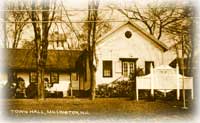Long Hill History is managed by several organizations. The Historic Preservation Advisory Committee (email questions to LHTHPAC@outlook.com)is a branch of the local government, appointed by the Township Committee and reporting on matters concerning historic preservation to the Planning Board, Zoning Board of Adjustment, Township Committee and any department of local or regional government requiring input or information.
A Brief History of Long Hill Township
 Long Hill Township, Morris County's southeastern-most municipality, covers 12.1 square miles and has a population of about 8,800. Named for a ridge of the Watchung Mountains, the township also encompasses parts of the Great Swamp and the Passaic River valley.
Long Hill Township, Morris County's southeastern-most municipality, covers 12.1 square miles and has a population of about 8,800. Named for a ridge of the Watchung Mountains, the township also encompasses parts of the Great Swamp and the Passaic River valley.
European settlers first arrived here during the 1730s. They farmed, established mills on the Passaic River in what would become Millington, and used the natural resources of the Great Swamp. The early trail that became Long Hill Road was their principal highway. These scattered settlements became part of Morris Township in 1740, including a region of southern Morris Township known as "Long Hill".
During the Revolution, local men served in the militia, and householders provided supplies to the troops at Jockey Hollow. The Continental Army placed a beacon at a high point on the long ridge to warn of enemy troop movements.
Throughout much of the nineteenth century, Long Hill was a sparsely populated farming community with centers of activity in the villages of Millington and Meyersville. The latter was named for Kasper Meyer, one of several German immigrant farmers who had arrived here early in the century.
Changes occurred after 1866 when the new municipality of Passaic Township was formed from Morris Township. In 1869 the Passaic Valley and Peapack Railroad purchased rights of way in the valley to extend railroad service from Summit to Bernardsville, and the Mutual Life Insurance Company of New York bought up 500 acres of farmland near the railroad. Here the company developed the factory village of Stirling, named for the revolutionary general William Alexander, known as Lord Stirling, who once owned land here.
The railroad also opened a station to the east on farmland owned by the Cornish family. The line's engineer named it Gillette to honor his fiancée, Rachel Gillette Cornish. Though the railroad brought a new immigrant population to Stirling, Gillette remained rural into the early twentieth century. The area had its own post office and general store.
Passaic Township's scenic hills and easy access to transportation attracted wealthy people from the city who built summer homes along the ridge overlooking Passaic Valley. A simpler summer colony was built South of Meversville.
At the end of World War 1, Passaic Township covered nearly 33 square miles on both sides of the Great Swamp. The township became its current size in 1922, when northern residents formed the new township of Harding.
In 1992 the community changed its name to Long Hill Township. Today, despite commercial and suburban development, Long Hill has many historic structures ranging from eighteenth century farmhouses to the twenty-first century September 11monument. They remind us of Long Hill's legacy as a place of villages, farms, mills, and factories, where working men and women of many nationalities contributed to the development of our nation.
text provided by the Morris County Heritage Commission, 2003

